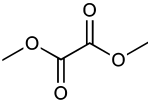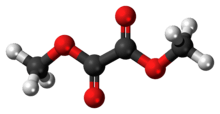Dimethyl oxalate
Dimethyl oxalate is the organic compound with the formula (CH3O2C)2. It is the dimethyl ester of oxalic acid. Dimethyl oxalate is a colorless or white solid that is soluble in water.
 | |
 | |
| Names | |
|---|---|
| IUPAC name
Dimethyl oxalate | |
| Identifiers | |
3D model (JSmol) |
|
| ChemSpider | |
| ECHA InfoCard | 100.008.231 |
PubChem CID |
|
| UNII | |
CompTox Dashboard (EPA) |
|
| |
| |
| Properties | |
| C4H6O4 | |
| Molar mass | 118.088 g·mol−1 |
| Appearance | White crystals |
| Melting point | 53 to 55 °C (127 to 131 °F; 326 to 328 K)[1] |
| Boiling point | 166 to 167 °C (331 to 333 °F; 439 to 440 K)[1] |
| -55.7·10−6 cm3/mol | |
| Related compounds | |
Related compounds |
Diphenyl oxalate |
Except where otherwise noted, data are given for materials in their standard state (at 25 °C [77 °F], 100 kPa). | |
| Infobox references | |
Production
Dimethyl oxalate can be obtained by esterification of oxalic acid with methanol using sulfuric acid as a catalyst:
Oxidative carbonylation route
The preparation by oxidative carbonylation has attracted interest because it requires only C1 precursors:[2]
The reaction is catalyzed by Pd2+.[3][4] The synthesis gas is mostly obtained from coal or biomass. The oxidation proceeds via dinitrogen trioxide, which is formed according to (1) of nitrogen monoxide and oxygen and then reacts according to (2) with methanol forming methyl nitrite:[5]
In the next step of dicarbonylation (3) carbon monoxide reacts with methyl nitrite to dimethyl oxalate in the vapor phase at atmospheric pressure and temperatures at 80-120 °C over a palladium catalyst:
The sum equation:
This method is lossless with respect to methyl nitrite, which acts practically as an carrier of oxidation equivalents. However, the water formed must be removed to prevent hydrolysis of the dimethyl oxalate product. With 1% Pd/α-Al2O3 dimethyl oxalate is produced selectively in a dicarbonylation reaction, under the same conditions with 2% Pd/C dimethyl carbonate is produced by monocarbonylation:
Alternatively, the oxidative carbonylation of methanol can be carried out with high yield and selectivity with 1,4-benzoquinone as an oxidant in the system Pd(OAc)2/PPh3/benzoquinone with mass ratio 1/3/100 at 65 °C and 70 atm CO:[4]
Use
Dimethyl oxalate is used for alkylation[6] and in the cosmetics industry as a chelating agent.[7]
For countries with low oil but large coal reserves (meaning countries with large potential for synthesis gas based chemistry, e.g. china), the oxidative carbonylation of methanol provides a promising approach to the important C2-basic chemical ethylene glycol.[8] Dimethyl oxalate can be converted into ethylene glycol in high yields (94.7%[9]) by hydrogenation at a copper-containing catalysts:[10]
The methanol formed is recycled in the process of oxidative carbonylation; therefore the only raw materials consumed in the overall process are carbon monoxide, hydrogen and oxygen. One plant following that coal-to-MEG process with a production capacity of 200,000 tons ethylene glycol per year is already operational in Inner Mongolia, a second plant with a capacity of 250,000 with tons/year was scheduled for 2012 in Henan.[11] Other plants with a total annual capacity of more than 1 million tons of ethylene glycol per year are planned.
Furthermore, dimethyl carbonate is accessible by decarbonylation from dimethyl oxalate at temperatures around 100 °C in the presence of alkali metal alcoholates, which is discussed as a fuel additive from biomass (so-called oxygenate):[12][13]
The formed carbon monoxide can be feed back to the reaction forming dimethyl oxalate (3).
Diphenyl oxalate is obtained by transesterification of dimethyl oxalate with phenol in the presence of titanium catalysts,[14] which is again decarbonylated to diphenyl carbonate in the liquid or gas phase. Diphenyl carbonate can be used as a replacement for the highly toxic phosgene for the production of polycarbonates.[15]
References
- P. P. T. Sah and S-L. Chien, Journal of the American Chemical Society, 1931, 53, 3901-3903.
- Hans-Jürgen Arpe: Industrielle Organische Chemie: Bedeutende Vor- und Zwischenprodukte, S. 168; ISBN 978-3-527-31540-6.
- US 4467109, Susumu Tahara et al., "Process for Continuous preparation of diester of oxalic acid", issued 1983-05-19, assigned to Ube Industries and EP 108359, K. Masunaga et al., "Process for the preparation of a diester of oxalic acid", assigned to Ube IndustriesEP 425197, K. Nishihira & K. Mizutare, "Process for preparing diester of carbonic acid", published 1991-05-2, assigned to Ube IndustriesUS 4451666, J.A. Sofranko, A.M. Gaffney, "Synthesis of oxalate esters by the oxidative carbonylation of alcohols", published 1984-05-29, assigned to Atlantic Richfield Co.
- E. Amadio: Oxidative Carbonylation of Alkanols Catalyzed by Pd(II)-Phosphine Complexes, PhD Thesis, Ca’Foscari University Venice, 2009.
- X.-Z. Jiang, Palladium Supported Catalysts in CO + RONO Reactions, Platinum Metals Rev., 1990, 34, (4), 178–180
- Alkylation with Oxalic Esters. Scope and Mechanism
- Marina Bährle-Rapp: Springer Lexikon Kosmetik und Körperpflege, S. 130; ISBN 978-3-540-20416-9.
- Nexant/Chemsystems, "Coal to MEG, Changing the Rules of the Game" (PDF). Archived from the original on July 14, 2011. Retrieved 2016-08-08.CS1 maint: BOT: original-url status unknown (link) (PDF; 5,4 MB), 2011 Prospectus
- 983 EP 046 983, S. Tahara et al., "Process for continuously preparing ethylene glycol", assigned to Ube Industries and H. T. Teunissen and C. J. Elsevier, Ruthenium catalyzed hydrogenation of dimethyl oxalate to ethylene glycol, J. Chem. Soc., Chem. Commun., 1997, 667-668), DOI:10.1039/A700862G.
- S. Zhang et al., Highly-Dispersed Copper-Based Catalysts from Cu–Zn–Al Layered Double Hydroxide Precursor for Gas-Phase Hydrogenation of Dimethyl Oxalate to Ethylene Glycol, Catalysis Letters, Sept. 2012, 142 (9), 1121–1127, DOI:10.1007/s10562-012-0871-8.
- http://www.icis.com/resources/news/2012/01/30/9527520/china-s-coal-based-chemicals-are-a-trade-off/
- Fond der Chemischen Industrie – Informationsserie Nachwachsende Rohstoffe: Stammbaum Biomasse-Produkte (PDF; 99 kB)
- US 4544507, P. Foley, "Production of carbonate diesters from oxalate diesters", assigned to Celanese Corp
- US 5834614, K. Nishihira et al., "Process for producing diaryl carbonate", assigned to Ube Industries, Ltd. and X.B. Ma et al., Preparation of Diphenyl Oxalate from Transesterification of Dimethyl Oxalate with Phenol over TS-1 Catalyst, Chinese Chem. Lett., 14 (5), 461–464 (2003), DOI:10.1016/s0378-3820(03)00075-4.
- JP 2011236146, "Method for Producing Diaryl Carbonate and Method for Producing Polycarbonate", assigned to Mitsubishi Chemical Corp.






